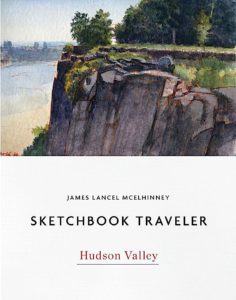Through the direst days of this crisis, we think of our friends and loved-ones, who also shelter in place. These are messages of hope, not just for our own survival, but the hope that when storm-flags are lowered, we might rediscover things we took for granted, drawing strength, wisdom and compassion from deeper engagements with nature.
Last week I published the first in a series of daily website blog-posts, of writings and artworks celebrating personal mobility, in pursuit of mindful engagements with history, nature and the environment. In relation to a finished painting, or an essay, this process is no less a work of art than is the tree to the fruit it bears. In a sense, this practice may be ceremonial, acts of reverence, in beholding the world around us. Offered as reaffirmations of hope and solidarity, these posts will appear every day, until these dark days are behind us.

Twin Bridges Below Roosevelt Boulevard On-ramp, Philadelphia. May 2, 2018.
Exploring the banks of the Schuylkill River in 2018, between the mouth of Wissahickon Creek and Fairmount Water-Works, I filled a sketchbook with journal-paintings. Later that year these would become a limited-edition suite of prints, and the centerpiece of the installation O.T.W. On the River, at Independence Seaport Museum in Philadelphia.
Twin Bridges at East Falls marks the western boundary of Philadelphia’s Fairmount Park. Popularly known as Twin Stone, they mark the western extremity of most barge-club rowing. Submerged rocks bid a cool welcome, yet dauntless oarsmen and women will venture upstream as far as Flat Rock near the vertiginous neighborhood of Manayunk.
Nearest the viewer, the Philadelphia & Reading Railroad Schuylkill River Viaduct, constructed of stone ribbed-skew-arch construction, the span was regarded as an engineering marvel when it was completed in 1856. Designed by engineer Gustavus Nicolls, its six arches were first modeled in soap. The bridge was constructed under the direction of master stonemason Christian Schwartz, who paid his workmen in coin and whiskey. The bridge beyond was added in 1890, creating a Y junction, merging the tracks on the east side of the river. A large masonry barrel-vault crosses Kelly Drive at its eastern head. The concrete span towering above them to the right is the northbound connecting ramp that links Interstate 76 to U.S. Route 1.
Efforts to restore the river have made great progress. One fouled with coal-silt and effluvia from sewage and industry
While painting this scene, I watched two brothers land a fifty-pound flathead. A passing restauranteur bought the catfish on the spot. Witnessing the transaction, a trio of snapping-turtles tread water offshore, in a patch of bright sunlight
(A preview of SKETCHBOOK TRAVELER by James L. McElhinney (c) 2020. Schiffer Publishing).
Copyright James Lancel McElhinney (c) 2020 Texts and images may be reproduced (with proper citation) by permission of the author. To enquire, send a request to editions@needlewatcher.com
